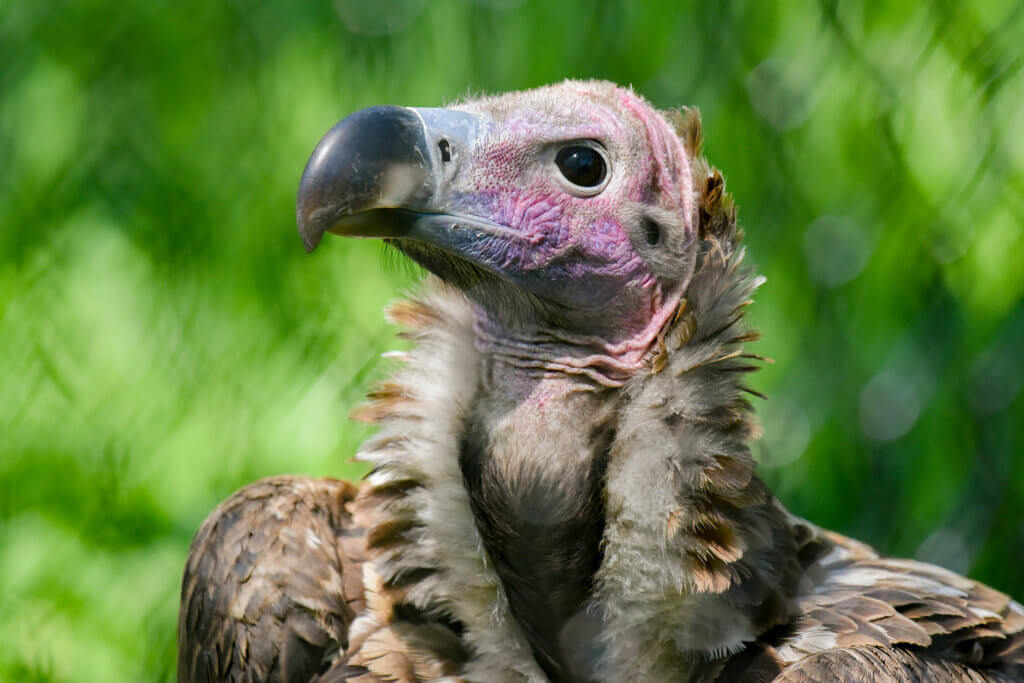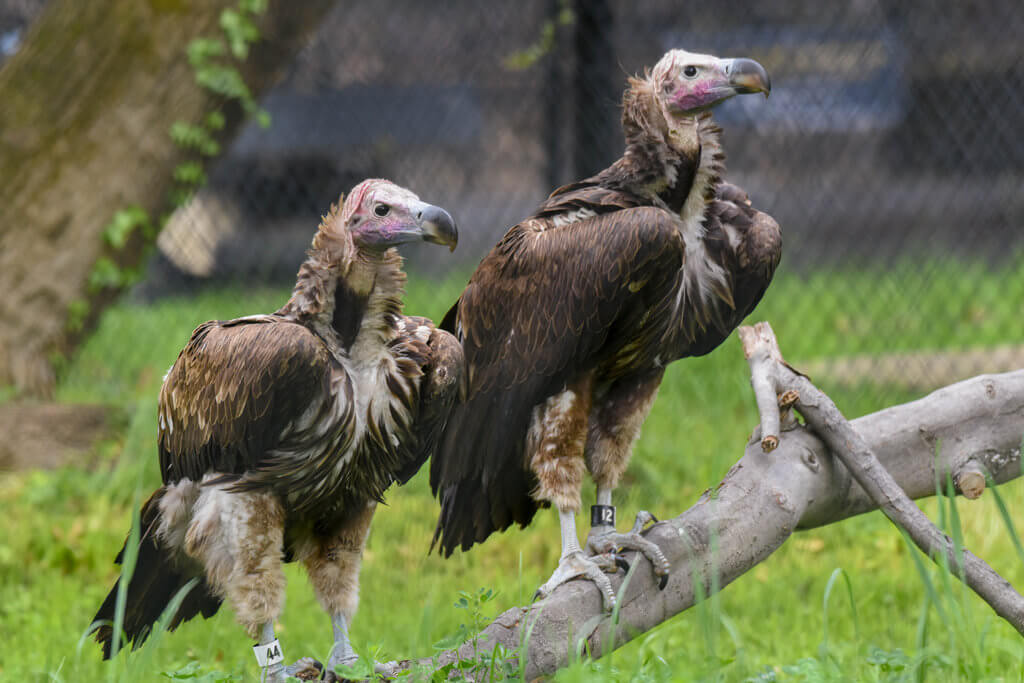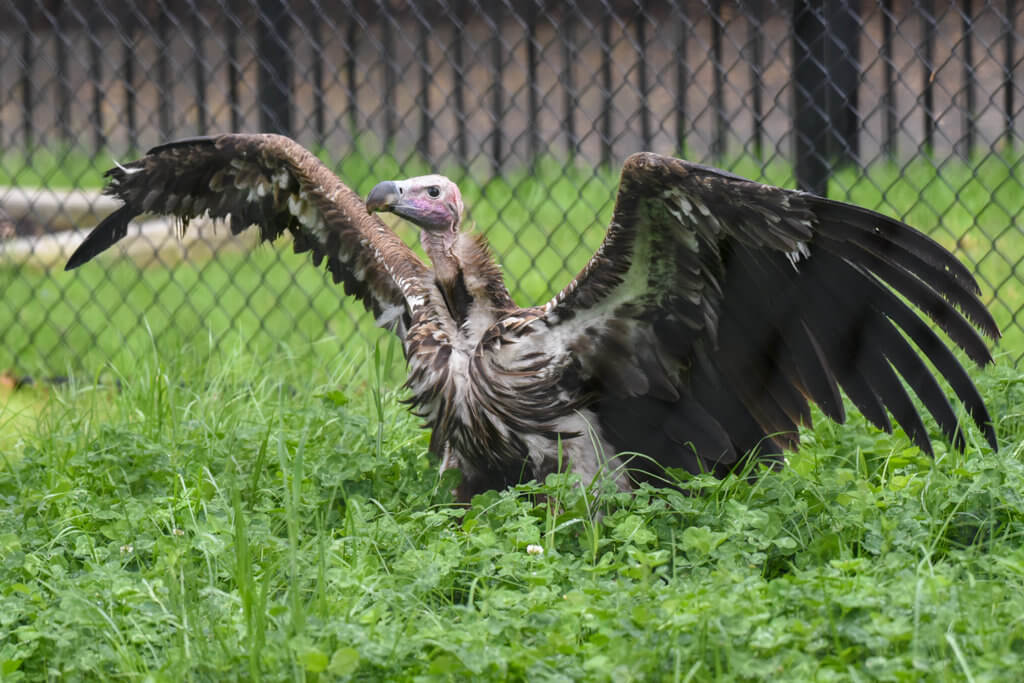Overview
“Where I live”
The lappet-faced vulture is native to much of Africa and the Middle East. Over most of its range, it inhabits dry and semi-arid land with only scattered trees, thorn bushes, and short grass.
“How I live there”
Lappet-faced vultures are typically solitary, spending most of their time alone or in pairs–unless congregating at a carcass. They roost in scattered trees, often acacia, on the open plains. A pair may be seen roosting near each other, in the same or adjacent trees.
These enormously powerful birds start foraging just after sunrise, once the thermals (warm wind currents) are strong enough to carry them aloft. They will range widely in search of carrion and prey. When they find a carcass, one or more will land nearby and join other scavengers at the feast. With their massive bills and large body size, lappet-faced vultures easily dominate other vultures and many other scavengers. They often remain on the outskirts of a feeding frenzy, attacking other birds and stealing their bits of meat.
Lappet-faced vultures survive primarily as scavengers, feeding on whatever carrion (dead animals) they can find. They will also hunt prey, including small mammals and birds, and even feed opportunistically on termites, locusts, and eggs.
Lappet-faced vultures are more able than most scavenger birds to rip into large carcasses. They break into a large carcass with heavy, sideways blows of their powerful bills. They will consume not only flesh but sinews, bone, and skin that often goes untouched by smaller vultures. After feeding, lappet-faced vultures will perch on the ground with wings outstretched and backs to the sun. After foraging all day, they return to roost at dusk.
“Making my mark”
The lappet-faced vulture is the largest vulture in Africa and now one of the rarest of all vultures. At the site of a carcass, it is easily distinguished from all other scavenger birds by its large size, pink-skinned head, and massive bill.
“What threatens me”
Young vultures are vulnerable to many different predators, including crows and African wildcats. Adults are less vulnerable to predation but are threatened by human activities. Widespread accidental poisoning has significantly reduced populations of lappet-faced vultures. The birds die when they consume bait laced with strychnine or other poisons that farmers put out for predators that threaten their livestock. Some birds also have reportedly died after scavenging the carcass of an animal that was poisoned. Lappet-faced vultures may be intentionally killed by farmers as well, who mistakenly believe that the large birds are a threat to their livestock. Poachers have been known to persecute these and other vultures because they believe that the birds circling overhead will reveal the location of a poached animal. In some parts of their West African range, these vultures also are hunted for food.
Raising Young
Lappet-faced vultures build solitary nests, usually containing only one egg. A pair will choose an acacia or baobab tree as a nesting site, or a rocky ledge if no trees are available. Pairs may build their nests several months in advance of egg-laying. They make their huge nests with sticks and line them with grass, camel hair, rags, and any other soft materials they can find. A pair will return to the same nest year after year for as long as it remains stable.
Once the female lays the egg, she and the male take turns incubating it for approximately the next two months. At hatching, chicks are covered in thick down and have the noticeably characteristic heavy bill. They are small and weak at hatching, but double in size within the first ten days of life. The parents initially feed the chick regurgitated food and then feed large pieces of meat. For the first three weeks, a parent bird is almost always on the nest. After that, they spend less and less time on the nest, but roost nearby.
The chick fledges (starts flying) after about three months and remains with its parents for another month or two. It may be dependent on its parents for food for as many as six months. Newly fledged lappet-faced vulture chicks can’t compete successfully with adults at a carcass, although they can out-compete smaller vultures.
Taxonomy
- Kingdom: Animalia
- Phylum: Chordata
- Subphylum: Vertebrata
- Class: Aves
- Order: Accipitriformes
- Family: Accipitridae
- Genera: Torgos
- Species: tracheliotos



